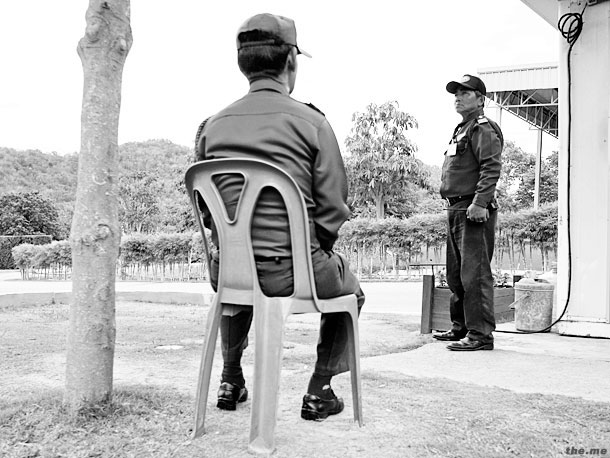This is not gonna be easy. Let me say before beginning this little hands-on review of the Ricoh GXR, the shooting experience turned out quite different from what I intended to expect. But that’s what reviews are here for. Using gear in the field is not about what’s promised in the shiny brochures of camera makers.

I had high hopes for this unique modular camera system. Expected a kind of toned-down Leica experience. Add the customized sensors. Unfortunately I struggled more with the camera than I had fun with. Didn’t really get the output I’m used to and was aiming for.
Who knows, this might be a typical case of “Don’t blame the gear, blame the shooter.” Rather a conflict with the alter ego? The GXR can churn out wonderful images and therefore work as a solid, reliable companion — depending on your shooting style and preferences that is. Boy was I excited at first…
Astonishingly, even I was able to pull quite useful images out of JPEG files I thought were lost. But there are limitations.
To begin with, I’d call the GXR a “nice weather camera.” If conditions are OK the GXR will respond alright. But once light fades, once your subject/object moves or you depend on manual focus, well, then better be prepared for a steep learning curve.

But first things first:
Revolutionary in Name
Each GXR “lensor” module, or correctly Camera Unit, consists of the lens, image sensor and image processing engine, allowing each unit to have these features optimized to one another and a specific task, whereas with conventional interchangeable lens cameras each different lens must use the same sensor and engine.
So you’re basically swapping cameras.
So you’re basically shooting an interchangeable camera system — or an interchangeable back system, to be precise.
Meaning, the GXR kind of offers you the likes of Leica X1/2, Sigma DP series and even Fujifilm X100 all in one…
Each lens unit has its own unique specifications relating to its sensor and optics meaning that different lens units will change the features, behavior and performance of the camera body to varying degrees when attached.
That’s what it says on paper. In theory this sounds like a perfect system. In the real world you might not notice too much difference though.
And what is considered to be the main selling point of the GXR turns out as its soft spot:
The GXR, announced in November 2009, has become an anachronism: a great concept, a well-thought-out idea that has been far drafted too long ago to keep up with these times of fast advancing technology.
Problem is: you’re stuck with a nice, but soon outdated sensor. If you want to modernize you’re forced to buy the whole new module. Meaning with each new lens you’re actually buying another sensor and another image processing engine.
To take a case in point:
Evidence that the whole system might be slightly outdated — and maybe even neglected by Ricoh — is the simple fact that in July 2012 on Ricoh’s global GXR webpage the A12 28mm F2.5 module is still listed as “New Product.” That lens module was released in September 2010.
A system, not yet three years old, and already sensing the end of its life cycle?
Lets first cut to the chase what the GXR has to offer. It’s basically a rangefinder experience. If you’re used to the power of a DSLR, then Ricoh’s GXR system is — in this day and age — unfortunately just not responsive enough. Take the 1.5 seconds start-up time, that’s just not today’s standard.
The competition seems to be lightyears ahead. But then again, photography is not about speed only and the competition. If you like the rangefinder experience and with a little bit of patience and properly handled the GXR can churn out very nice results.

You’ll enjoy many aspects.
First of all, it’s a “closed” system. By changing lenses you don’t expose the image sensor. At least in theory. So no more dust worries. That’s why the GXR has no sensor-cleaning mechanism.
But then again, it’s all but foolproof protection. You’ll find reports on the Web of GXR shooters saying, “Now what? I got dust on my sensor.”
Chances are you’ll have to send the unit in for a cleaning.
Ricoh says, “It’s difficult for dust to get in.”
Still, you’ll change lenses with less fear.
Another GXR bonus: the system’s relatively small size.
At the time of launch the GXR system was praised as the world’s smallest and lightest digital camera with interchangeable lenses. That was back then. We all know how Micro Four Thirds, announced in August 2008, progressed since then.
What else is to love? The on/off switch is at the right position, just where it belongs to. You switch the camera on and off where your thumb’s natural position is. Simple, negligible, but nice.
The Comfy Cam
More importantly, the GXR’s ergonomics feel just right. The grip, the balance, the overall weight and size, all the parts of this modular camera add up to an amazingly comfortable camera.
Yes, comfortable. You’ll feel immediately at home holding the GXR. Not too big, not too small, just right with well-placed buttons.
Ricoh got many things right on this “revolutionary” camera. You get an intuitive and photographer-friendly hardware with a Ricoh UI that reveals the more secrets the more you use it. Complex stuff, to say the least.
Also, the menu has a basic function every camera menu should have. When pressing the Menu button you’ll enter where you last left.
Furthermore, the main dial has a lock. You’ll laugh, but that’s not so common anymore! Don’t know about you, but I somehow switch modes all the time — accidentally – with a camera that has no main dial lock.
And interestingly, the GXR’s shutter speeds aren’t limited to the usual 1/60, 1/125, 1/250, and so forth. You get “rolling” shutter speeds, such as 1/68 or 1/203 or 1/930, each giving you the optimum value.

And take the GXR’s multi-pattern auto white balance, a useful setting for scenes with mixed lighting — daylight and flash, for example, or fluorescent and daylight.
Instead of just taking an average reading from the whole scene, which inevitably gets the white balance wrong for the secondary light source, the GXR breaks the image down into small areas and analyzes and sets the white balance for each one.
You’ll most likely see a subtle but noticeable gain in IQ that is quite useful for capturing more natural portraits when using flash.
What else to love? Snap Focus. Set the distance at either 1m, 1.5m, 2m, 2.5m, 3m, 3.5m, 5m or ∞.
Why to love it? Well Snap Focus covers the rather pathetic autofocus. Just shoot and you’re sure to nail it. Great for street photography.
Snap Focus is a great alternative because the GXR autofocus is, as said, not the fastest. It’ll inevitably hunt in dim light. To be on the safe side — and not being a friend of manual focusing — you get the “snappier” Snap Focus backup option.
As an Fn function I’d wish to change Snap Focus distance in a whiff. Menu only allows Focus Mode changes. To change the focus distance you have to dig deep into the menu…
Well I stand corrected on this one. Would I have spent a little more time with the GXR I might have found out that you just hold the Macro button and spin the values with the front wheel…
2.5m is a fine distance for street photography. Or you can always go ∞ with a relatively high aperture setting. Depth of field will be reasonably deep, so chances are you nail even more shots.
Avoid Spot AF at any cost in low light, the contrast-based autofocus just won’t cut it. Multi AF works much better.
I reckon AF speed might also has to do with each module, meaning a newer module will focus faster?
I was testing the A12 (12 stands for 12MP) 28mm and 50mm macro modules, each F2.5. That’s right, not the fastest aperture. And the 28mm isn’t really wide enough while the 50mm macro is neither fish nor fowl. Maybe a bit short for macro work.
Hence, Ricoh’s lens choices don’t serve everyone’s needs.
As of mid-2012 GXR offers six camera units covering the range of 24mm to 300mm.
Regarding sensor equivalence, that’s the focal length in full-frame terms. The 28mm is in fact an 18.3mm, the 50mm a 33mm.
A newer addition is the A16 24-85mm F3.5-5.5 zoom module. Again, not the fastest in terms of aperture… I wonder why they’re not aiming higher? Newer, more pixels, faster? And I’m talking faster aperture AND autofocus.
At least the — albeit slowly — growing lensor choice and a Leica M mount module make the GXR a clearly more interesting beast.
In my book the Leica M module is the GXR’s raison d’être. More on this further below.
The system’s true Achilles’ heel is that you most likely grow tired of buying sensors over and over again. Especially considering how the older Sony sensor is at least a generation behind the times.
Also, JPEG has come a long way since. The GXR has to be shot RAW. The Ricoh JPEG engine is decent but RAW is far superior. If you’re a JPEG-only shooter, well…
But then again, good photography is hardly about ever new gear, isn’t it… Henri Cartier-Bresson might make any camera dance.
Let’s move on to the GXR’s high ISO performance.
ISO is capped at 3,200, that’s already pretty low in today’s imaging world.
1,600 with the standard lensors will give you nice quality. Base ISO 200 is superb.
The P10 lensor is another story. It’s 28-300mm range does offers ample flexibility in terms of range, but high ISO will disappoint according to reviewer Thom Hogan.
And frankly, if you want a wider zoom range there are better compact camera options out there.

Menu, Menu on the Wall…
Also the menu and settings need some time to get accustomed to. I find my way usually more easily through a camera’s inner workings. It’s a kind of a jungle, the GXR menu, with tons of interconnected features and options, and the printed manual in the box omits a lot, doesn’t it.
And each module has to be set up individually, otherwise default settings are applied… Wrong again. With a little bit insistence you’ll find out that you can also exchange your settings from module to module very easily. They don’t have to be set up individually.
Take your time for getting to know the GXR and use the trial-and-error approach.
Chances are, for instance, that you’ll accidentally hit the self-timer button and wait for the shutter to kick in. You wanted to delete an image and you unintentionally enabled self-timer — well those functions share the same button. By pressing the button (when NOT in reviewing mode) you activate self-timer.
Not less awkward is when using manual focusing you have to press the macro button at the same time to enable manual focusing…
BTW, you can’t tilt the LCD screen, but the external viewfinder. The viewfinder is a nifty addition that belongs into every GXR shooter’s bag.
Focus on Focus
GXR offers you so many focusing option you might even get confused.
Ricoh — not keeping things simple — gives you Snap Focus, Full Press Snap, Manual, Manual Override of Autofocus and Focus Lock.
“Pure” manual focusing is furthermore supported in several ways:
- Depth-of-Field Display: For all three manual focus modes in Ricoh lenses, a distance scale with green depth-of-field indication is displayed in the viewfinder/LCD display.
- Enlargement (three steps): A section of the picture can be enlarged 2x, 4x, or 8x. Either, a section of the display shows the enlarged section (lower quality), or the enlarged section is shown full screen (better quality). The enlarged section can be moved in either mode.
- Focus Assist (two methods): The GXR offers two methods for supporting manual focusing: Mode 1 creates “sparkling” edges in a colored image, Mode 2 emphasizes edges in a black-and-white image (highpass filter).
It is said, BTW, the focus assist in the GXR EVF is the best of any mirrorless.
The Full Press Snap feature allows you to take a photo at one of the Snap Focus mode distances with a full press of the shutter button.
This means that you can use both the camera’s autofocus system by half-pressing the shutter button, and override it to instantly shoot at at a predetermined distance without having to wait for the camera to focus.
Then you have Pre-AF, accelerating the focusing time by following the subject’s movement before the shutter release button is pressed half-way. But this only works when the focusing is set to Multi AF or Spot AF.
Interesting is the focusing peaking of the Ricoh GXR M module for Leica M mount lenses. Haven’t tried it myself. Reviews — such as Luminous Landscape‘s — suggest it might be in the same league as Sony NEX’s focus peaking.
On the A12 mount for M Leica lenses Ricoh offers two focus assist options that, in principle, enhance the EVF image with a shimmering white outline that appears around subjects/objects with high local contrast, similar to the “peaking” focus used in many video cameras as well as Sony’s newer NEX cameras.
So you basically get a $1,000 digital Leica with a slightly larger crop factor than the M8 — with a focusing method that makes focusing a breeze.
The Ricoh GXR M module is a no-brainer if you have Leica legacy glass — so there we might have found the system’s real purpose.

THEME’s Take:
When the GXR was launched it was a mighty idea. Cameras evolved substantially, if not dramatically since.
The Ricoh GXR is a beautiful system that earned its place in a niche market — but it’s not particularly well-thought-out for the long run.
You get great ergonomics, reliable output — but ergonomics are a relative thing and today you get most likely at least equal quality in a similarly sized package that’ll burn a much smaller hole in your pocket.
The competition is ahead, whether regarding autofocus, megapixel count, ISO range or lens selection.
Especially Micro Four Thirds and Sony NEX make the GXR system kind of redundant.
Or you shoot mainly prime glass? Well that’s the photographer Ricoh is primarily aiming at with the GXR, even though it’s easier to carry around single lenses than single lensor lens modules…
You own Leica M, Zeiss or legacy lenses? Then the GXR is a great backup camera.
Ricoh offers two Focus Assist options for the Leica M module that, essentially, enhance the EVF image with a shimmering white outline that appears around objects with high local contrast. This is similar to the “peaking” focus system used in many video cameras as well as Sony’s newer NEX cameras.
Again, the GXR is essentially a rangefinder approach, and the rangefinder approach is a very own, peculiar style of shooting. It’s mostly about anticipation.
You either like it or you don’t. I do, and I still didn’t feel at home.
But that’s emotional arguing. More importantly, even if you’re only occasionally into action photography, quintessentially Ricoh’s GXR system has no action module for you.
Add the slow shot-to-shot performance. GXR is not for action shooters.
You want to document your kids growing up? Rather become a landscape photographer if you really want the GXR.
The system is for photographers with patience and time, for people who cherish careful composing and are in no rush whatsoever.
Overall, GXR leaves me with very mixed feelings. Back at launch of this system I’d certainly have written a different review. But time goes on, things evolve and the Ricoh GXR system kind of stands still. Buyers should honestly expected more. But then again, the competition’s just to good.
I recently worked with the Olympus OM-E E-M5 and Canon 5D Mark III. Now that’s not fair, you’ll say. Those are completely different systems? True, and they’re clearly much more responsive, agile, elaborate tools.
Isn’t that what the market wants.
The GXR is, unfortunately, a thing of the past that has quickly come of age. Period.
Or, again, you’re more of a rangefinder kind of guy where speed and performance matter differently.
GXR brings you part of the rangefinder experience where you can guesstimate the focus distance and select the preferred aperture. You’ll definitely feel more connected to the experience of shooting than with a bulkier DSLR.
In the end though the GXR offers too many disadvantages instead of advantages. The lens modules are solid APS-Ce performers. Equipped with today’s technology they could be no-brainers. But they’re stuck in the past, at least in my book.
ISO 3’200 max is so last decade. Period.
Would I buy it?
Yes, if I own Leica M mount glass. At a fraction of the price of an M9 the Ricoh GXR is an appealing camera offering live view and many features to use with Leica lenses.
Add the plus that due to its lack of an AA filter the M mount can produce images of exceptional resolving power that compare to at least a 16MP sensor with a touch more noise.
Chapeau Ricoh, it takes courage to build this kind of interchangeable sensor modular camera. It’s nothing for novelty seekers, but rather for aficionados of the fine arts.
With the new relationship between Ricoh and Pentax we might even expect a Pentax AF mount — or a new, revised, modernized GXR-something.
That’s hopeful thinking. More importantly current owners and future buyers might want to see replacements of the aging A12 modules to freshen up the system with better sensors and hopefully faster lenses as well as improved shot-to-shot performance.
To be honest, though, keep your hopes in check for the future of the GXR system.
UPDATE: Mid-July, 2012, Pentax is basically confirming that the GXR system’s future is in the balance. Noboru Akabane, president of Pentax Imaging Ricoh, announced plans to abolish future Pentax compact digital cameras and focus on DSLRs. All future compact cameras will be under the Ricoh brand while DSLR and mirrorless camera will be under the Pentax name. It is not clear what will happen with the Ricoh GXR system.
+++ Well, after all you might be even more convinced that the GXR modular system is for you. You can order Ricoh GXR system from Amazon U.S. or Amazon U.K., Canada, Germany, France, Italy or Spain.
(Thanks for the loaner East Enterprises)









